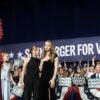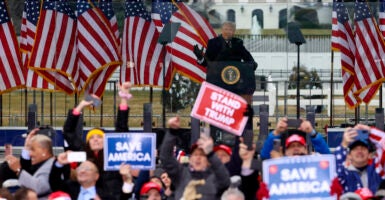If and when the Senate holds its second impeachment trial of Donald Trump, this time after he no longer is president, one argument in his defense may well be based on a legal precedent that has guided incitement cases since 1969.
The House of Representatives impeached the president Wednesday for “incitement to insurrection” because of Trump’s speech at a rally a week earlier as Congress began to debate objections to certifying President-elect Joe Biden’s Electoral College victory. That protest Jan. 6 turned into a deadly riot when a mob of hundreds overran security and broke into the Capitol.
Here are four things to know about the crime of incitement.
1. What Does the Supreme Court Say About Incitement?
The standard of proof in a criminal case is much much higher than for impeachment of a federal official. But the legal bar for prosecuting incitement is quite high, thanks to the “Brandenburg test” established by the Supreme Court in 1969.
The Brandenburg test requires that however inflammatory speech may be, the government can’t prosecute unless the speech is directed at inciting violence and poses an imminent threat of violence, and violence is likely to occur.
“The president’s defense team should raise this as a matter of law, but politics is not the law,” Matt Pinsker, a former federal prosecutor and author of the textbook “Homeland and National Security Law and Policy: Cases and Materials,” told The Daily Signal.
“I’ve read the text of the Donald Trump speech and it doesn’t meet the time, place, and manner test or the legal standard under Brandenburg,” said Pinsker, an adjunct professor of government and public affairs at Virginia Commonwealth University whose expertise includes how homeland security law may conflict with the First Amendment.
D.C. Attorney General Karl Racine is investigating potential charges against the president and other speakers at the rally preceding the riot.
Even if a speaker clearly advocated violence, by law the threat still would have to be imminent. In proving an imminent threat, Pinsker said, courts would look at a “cooling off” period.
“I have lived in D.C. and it is about a 40- to 45-minute walk from where Trump spoke to the Capitol,” Pinsker said. “That would not be imminent. If he gave this speech near the Capitol steps, it might be imminent, but it would be lacking other standards.”
2. What Does Federal Law Say?
Similarly, laws on the books require intent.
The federal statute defines an insurrectionist as “Whoever incites, sets on foot, assists, or engages in any rebellion or insurrection against the authority of the United States or the laws thereof, or gives aid or comfort thereto.”
Federal riot law includes a provision on those “with intent” to “incite a riot” or to “aid and abet any person in inciting or participating in or carrying out a riot.”
3. What Did Trump Actually Say?
The biggest mitigating factor, if Trump were being prosecuted in a legal setting, would be the president’s call for attendees at the “Save America” rally near the White House to “peacefully” march to the Capitol.
Trump’s speech preceding the riot was harshly criticized on both sides of the political aisle.
“I know that everyone here will soon be marching over to the Capitol building to peacefully and patriotically make your voices heard,” the president told the large gathering.
However, Trump made other comments that could be interpreted differently.
“Fraud breaks up everything, doesn’t it? When you catch somebody in a fraud, you’re allowed to go by very different rules,” he said.
The president also said: “We fight like hell and if you don’t fight like hell, you’re not going to have a country anymore.”
Also, Trump tweeted to his supporters Dec. 19, weeks before the rally: “Big protest in D.C. on January 6th. Be there, will be wild!”
Still, most of Trump’s rallies tend to be wild, Pinsker said, and on Jan. 6, the events that followed were not foreseeable–at least not in a legal setting.
“If I were prosecuting the case, I would raise all these points,” Pinsker said. “Since Trump began running for president, he said things that upset people and has said more inflammatory things in the past than he said at this rally. There is legal precedent, but there is also factual precedent. The facts don’t bear out that his past rallies led to violence.”
4. What Legal Cases Are Relevant?
Cornell Law School points to Supreme Court cases that affirmed the Brandenburg test. A significant difference between these cases and the Capitol riot would be that the rulings did not involve instances before actual violence occurred.
The first relevant legal case established the test, Brandenburg v. Ohio.
Clarence Brandenburg was a leader of the Ku Klux Klan’s Ohio branch. It held a rally in the summer of 1964, during which Brandenburg said: “If our president, our Congress, our Supreme Court continues to suppress the white, Caucasian race, it’s possible that there might have to be some revengeance [sic] taken.”
Brandenburg then went on a rant about Jews and blacks.
He was charged with and convicted of violating an Ohio law against “advocat[ing] … the duty, necessity, or propriety of crime, sabotage, violence, or unlawful methods of terrorism as a means of accomplishing industrial or political reform,” as well as “voluntarily assembl[ing] with any society, group or assemblage of persons formed to teach or advocate the doctrines of criminal syndicalism.”
But in 1969, the Supreme Court overturned Brandenburg’s conviction in an opinion that said:
Freedoms of speech and press do not permit a State to forbid advocacy of the use of force or of law violation except where such advocacy is directed to inciting or producing imminent lawless action and is likely to incite or produce such action.
Only a few years later, in 1973, this standard was tested in the case of Hess v. Indiana. An Indiana University protester was charged with incitement for saying, “We’ll take the f—ing street again.”
The high court ruled that the protester’s profanity was protected under the Brandenburg test, since the speech “amounted to nothing more than advocacy of illegal action at some indefinite future time.”
Further, the court determined, “since there was no evidence, or rational inference from the import of the language, that his words were intended to produce, and likely to produce, imminent disorder, those words could not be punished by the State on the ground that they had a ‘tendency to lead to violence.’”
In 1982, the Supreme Court ruled in the case of NAACP v. Claiborne Hardware Co., after civil rights activist Charles Evers threatened violence against people who wouldn’t boycott white businesses in Mississippi.
Strong and effective extemporaneous rhetoric cannot be nicely channeled in purely dulcet phrases. An advocate must be free to stimulate his audience with spontaneous and emotional appeals for unity and action in a common cause. When such appeals do not incite lawless action, they must be regarded as protected speech.































